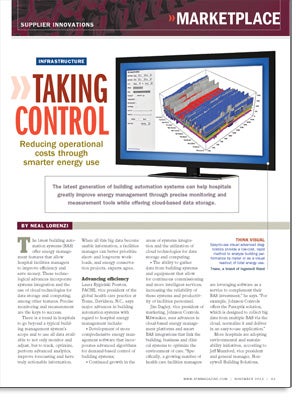Taking control

The latest building automation systems (BAS) offer energy management features that allow hospital facilities managers to improve efficiency and save money. These technological advances incorporate systems integration and the use of cloud technologies for data storage and computing, among other features. Precise monitoring and measurement are the keys to success.
There is a trend in hospitals to go beyond a typical building management system's scope and to use all data available to not only monitor and adjust, but to track, optimize, perform advanced analytics, improve forecasting and have truly actionable information. When all this big data become usable information, a facilities manager can better prioritize short- and long-term workloads, and energy conservation projects, experts agree.
Advancing efficiency
Laura Rygielski Preston, FACHE, vice president of the global health care practice at Trane, Davidson, N.C., says major advances in building automation systems with regard to hospital energy management include:
• Development of more comprehensive energy management software that incorporates advanced algorithms for demand-based control of building systems;
• Continued growth in the areas of systems integration and the utilization of cloud technologies for data storage and computing;
• The ability to gather data from building systems and equipment that allow for continuous commissioning and more intelligent services, increasing the reliability of these systems and productivity of facilities personnel.
Jim Dagley, vice president of marketing, Johnson Controls, Milwaukee, sees advances in cloud-based energy management platforms and smart BAS integrations that link the building, business and clinical systems to optimize the environment of care. "Specifically, a growing number of health care facilities managers are leveraging software as a service to complement their BAS investment," he says. "For example, Johnson Controls offers the Panoptix solution, which is designed to collect big data from multiple BAS via the cloud, normalize it and deliver in an easy-to-use application."
More hospitals are adopting environmental and sustainability initiatives, according to Jeff Mumford, vice president and general manager, Honeywell Building Solutions, Minneapolis. To achieve these certifications, buildings require more advanced HVAC capabilities and information on energy use. "As a result, BAS have become more sophisticated in monitoring energy use throughout a facility. They enable facilities managers to quickly access that information through mobile devices, dashboards on desktops or template reports preloaded in the BAS," he notes.
There is definitely a trend toward more energy monitoring and reporting, says Ron Holdaway, P.E., CEM, LEED AP, senior design principal of the consulting firm Smith Seckman Reid (SSR), Nashville, Tenn. In fact, measurement and verification of energy systems are becoming the standard rather than the exception.
"Engineers are specifying sensors and meters to fully measure and validate the energy-consuming systems in buildings. Wherever possible, engineers are designing the electrical distribution systems to segregate the electrical loads, HVAC, fans, lighting, plug loads, domestic water and heating," he says.
"Power monitoring gear is specified in the distribution panels, which are interfaced to the BAS," he continues. "More meters and sensors are being designed for the building's thermal systems and these are directly monitored by the BAS. With segregated measurement, we can measure, document and compare consumption of each system, not just the total building energy use."
Systems integration
BAS are expanding their capabilities to improve building energy functions, such as heating/cooling and lighting control, experts say. Many facilities managers are using their BAS to adapt to changes in occupancy levels throughout the day. For example, if a noncritical area of the hospital is unoccupied for an extended period, the BAS can temporarily scale back HVAC systems in that area and shut off lights to conserve power. BAS also are used to tap energy-use data to help manage the facility's overall energy load, which helps to maintain the hospital's energy capacity and avoid energy tariffs.
"BAS have the capability to integrate with many different types of systems within a hospital," says Rygielski Preston. "The open protocols of today's control systems as well as the standard databases used by other software allow BAS to make intelligent decisions regarding energy management." For example, the ability to adjust the temperature, humidity and air-change setpoints according to the schedule for an operating suite improves energy use in this critical area of a hospital. Lighting and ventilation control based on occupancy and carbon dioxide also reduce energy use.
Siemens now offers a distributed lighting control system that is integrated with the BAS to control 25 to 40 percent of energy used for lighting in a hospital, according to John Nicolson, business line manager for room automation with Siemens Industry Inc.'s building technologies division, Buffalo Grove, Ill. "With this system, the facilities manager can monitor and control all aspects of lighting from the same station used for the BAS. This distributed control capability allows for the most granular control of lighting possible, which saves energy," he explains.
Most vendors provide energy management modules that work in conjunction with BAS, according to Mumford. These modules allow complex models of the building to be used for analysis and decision-making. "For example, if a facilities manager is working on a system to optimize heat recovery and trying to decide if pre-cooling strategies are necessary, the building's BAS can determine the best way to operate heating or cooling and do it automatically. Also, new models incorporate information from building information modeling (BIM), which allows for a more detailed analysis," he explains.
Energy Management Information Systems (EMIS) represent the next evolutionary step in BAS, says Mike DeNamur, LEED AP, vice president, strategic marketing and sales, Automated Logic Corp., Kennesaw, Ga. "EMIS add a layer of intelligence to sift through the vast quantity of data collected by the BAS. Anomalies found by EMIS may indicate hidden problems that the BAS was correcting (e.g., simultaneous heating and cooling), which if fixed could result in energy savings. Other metrics, such as energy use per square foot, identify and prioritize opportunities for operational improvements," he says.
"Where BAS have focused on addressing the two dimensions of changing weather and occupancy in the past, the addition of EMIS and higher-order, dynamic control sequences allow today's building to shift gears to accommodate a third dimension — the change in price or availability of utilities," he adds. "Forward-thinking owners are using these strategies to proactively manage facilities in ways not dreamed of in the past — and to the realization of significant financial benefit."
Third-party software
Can hospitals use BAS to analyze their energy data, or do they need third-party software? According to SSR's Holdaway, all BAS have the data available. "However, I have found the best results require third-party software to effectively drill down and present the energy-consumption data. Even the major BAS vendors offer add-on packages for dashboards to present the data," he says.
Most BAS are capable of gathering and analyzing energy data at some level and carrying out automated functions based on this analysis, according to manufacturers that supply the nation's hospitals. There also are options for energy management software that run more complex analytics that will integrate with a facility's BAS.
Trane recently developed diagnostics software that offers a rapid method to analyze building energy performance. It provides three-dimensional visualization of performance issues, shows intrabuilding and interbuilding variation, and allows owners to identify and quantify optimization opportunities while evaluating performance through benchmarking.
According to Dagley, today's BAS can operate as comprehensive building efficiency systems, without the need for third-party software. Operating on an open platform, they can simplify the complex process of collecting real-time building data from disparate systems and create a single integrated view of system operation. "With visibility into facility metrics, a building manager can make better decisions to optimize energy savings and building performance," he says.
Given the hectic nature of their business, hospital facilities managers sometimes can overlook the energy management capabilities of their BAS. "Many have faced cutbacks in staffing and struggle to complete the day's workload, not allowing them time to fully utilize the energy management capabilities available today," says Nancy Merritt, key account manager, health care, Schneider Electric, Palatine, Ill. "They also are subcontracting work to different contractors and integrators, which can compound the problem."
A comprehensive approach to maintenance, such as the HealthBuildings Risk Assessment program recently developed by Schneider Electric, can help these managers understand, rationalize, rank and prioritize the deficiencies that exist in their facility infrastructure — specifically within their security technology, mechanical systems, BAS, data centers and electrical distribution systems, Merritt says.
Off-site challenges
As health care organizations grow through mergers and acquisitions, push services farther out into their communities and move more services to outpatient care, off-site health care facilities pose even greater energy management challenges to facilities managers. Experts agree that these trends will challenge building managers to monitor energy usage, analyze it and take action on that information remotely, across multiple facilities and campuses that may have different BAS.
As systems expand with smaller off-site health care facilities, the challenge for energy management increases exponentially, says Merritt. "Facilities managers will have even more buildings to manage, often with the same staff, with more disparate systems and devices to learn and operate. Being able to integrate all of these buildings and systems into a unified platform, which can be managed in real time, is the key energy management challenge," she notes.
Sophisticated controls are needed in many of these smaller sites due to the sensitive nature of health care operations, so while the systems and facilities are smaller and somewhat less complex from a scale perspective, the control capabilities cannot be viewed as less complex or less important, according to Chris Hollinger, senior product manager for building automation controllers with Siemens Industry Inc.'s building technologies division. "Application of the correct HVAC solutions to address the comfort, energy savings objectives and regulatory expectations is still critical," he notes.
BAS vendors are developing health care-related products for this new era of more accountable health care, experts agree.
"BAS systems will play a critical role," says Dagley of Johnson Controls. "Increasing compliance and clinical accountability needs are driving smarter integrations. One example can be found in the operating room where we are linking BAS with surgical scheduling to optimize energy use in the often-unoccupied OR suite, while increasing clinical productivity and reducing risk through surgical event and environmental documentation dashboards."
It is likely that the requirements of new health care policies will make BAS even more important to the success of health care organizations, adds DeNamur. "However, many of the applications will not require significant new product development, rather just creative application of existing technology and an interest and commitment on the part of facility operators to use their BAS to the fullest potential."
Neal Lorenzi is a freelance health care writer based in Mundelein, Ill.
| Sidebar - For more information |
| For further details on the building automation systems featured in this month's "Marketplace" article, readers can contact the following vendors: »Automated Logic Corp. »Honeywell Building Solutions »Johnson Controls »Schneider Electric »Siemens Industry Inc. »Trane, a brand of Ingersoll Rand |



